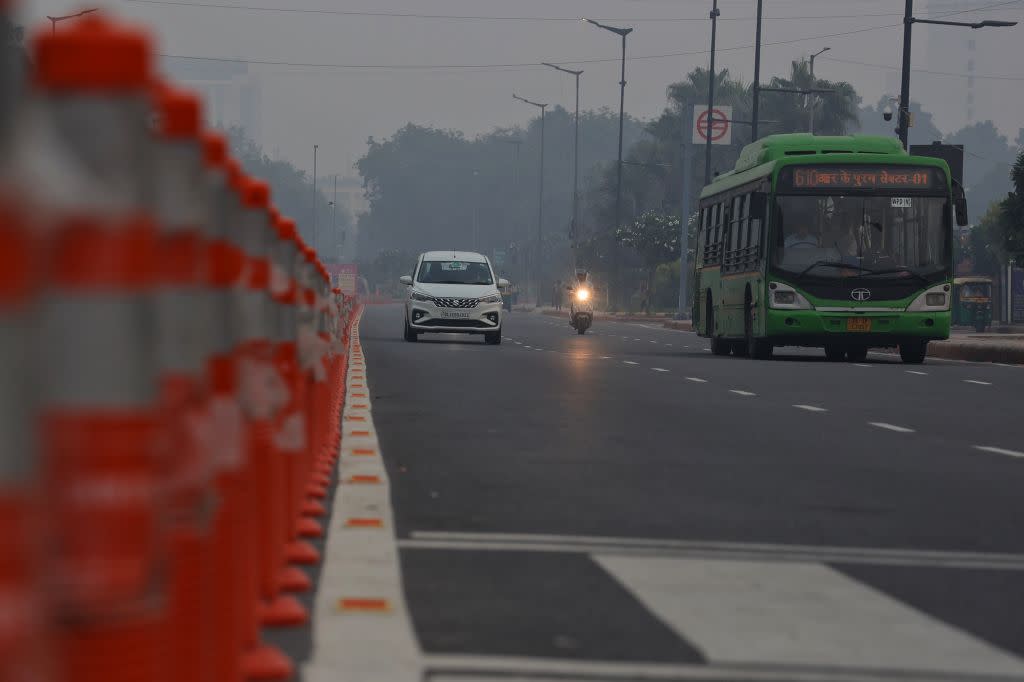Planners Are Hoping That Electric Vehicles Will Help Save the World’s Most Polluted City

Vehicles move amid smoggy conditions near India Gate in New Delhi on Oct. 27, 2022. Credit - Nasir Kachroo—NurPhoto/Getty Images
The clock is ticking in New Delhi. As another November approaches in the Indian capital, millions of residents will be left gasping for breath because of notorious seasonal smog.
Schools will be shut down. The vulnerable will be advised to stay indoors. Hospitals will become crowded with people suffering from respiratory illnesses.
Traditional agrarian practices kickstart this yearly health emergency. Farmers in the states of Uttar Pradesh, Haryana and Punjab prepare for the sowing of new crops by burning off the stubble left from the harvest. This smoke spreads to Delhi, where it mixes with winter fog, dust, and vehicular and industrial emissions to form a toxic miasma.
Then come the annual celebrations of the Diwali holiday, the festival of lights. Despite being banned, firecrackers fill the skies with smoke, causing pollution levels to spike even further. A day after Diwali, which this year fell on Oct. 24, the air quality in Delhi turned “very poor,” according to the Central Pollution Control Board.
But underlying all these seasonal factors is the constant of extremely high vehicular emissions.
According to a survey by the Centre for Science and Environment, a New Delhi-based research and advocacy organization, emissions from two-, three- and four-wheeled vehicles account for more than half of Delhi’s particulate pollution.
Delhi has now replaced Beijing as the city with the world’s worst air. The human toll is high. In 2020, there were about 54,000 premature deaths attributable to pollution in New Delhi alone. Nationwide in India, air pollution is estimated to kill more than two million people a year. Lung cancer, usually associated with smoking, is increasing rapidly among non-smokers, and every three minutes a child dies in India because of air pollution.
Small wonder that authorities at municipal, state and federal levels are racing to avert Delhi’s annual airborne catastrophe with a raft of measures, including crackdowns on construction site dust, waste burning and firecrackers, as well as a recently launched “Green War Room” to monitor pollution data and ensure implementation of specific measures. At the center of the plans to make the Indian capital more livable is an ambitious shift to electric vehicles.
The boldest component of New Delhi’s war on pollution is the Delhi Electric Vehicle Policy, which was launched in August 2020. It aims to make New Delhi “the EV capital of the world,” with 25% of all new vehicles on the city’s roads by 2024 to be powered by electricity.
To help achieve this goal, the city established a number of subsidies and incentives that seem to be working. Sales of electric vehicles have increased by roughly 40% since the implementation of the policy two years ago—more than 72,000 electric vehicles have been sold, and electric vehicles now account for close to 10% of all vehicles being sold each month according to figures cited by the transportation department. Although the policy has been in effect for around two years, it is still too early to assess whether pollution levels have dropped marginally.
The shift toward electric vehicles isn’t just focused on cars. Two- and three-wheelers make up 75% of all vehicles in Delhi, and the Delhi EV Policy includes incentives for e-bikes and e-rickshaws. Recently, the government announced that charging stations will offer low-cost charging for these smaller electric vehicles.

Unfamiliarity, however, is one issue holding back greater adoption of electric vehicles. “People want to be sure of EVs before letting their non-electric vehicles go,” says Ashish Rao Ghorpade, deputy director of the International Council for Local Environmental Initiatives—a global network of municipal authorities that have pledged themselves to sustainable development.
Affordability is also a significant deterrent for Indian consumers, for most of whom car ownership is a distant dream. The average cost of an electric vehicle in New Delhi is roughly $20,000, while an average, entry-level fossil- fuel car can be bought for less than $5,000. Per capita income stands at just $4,800.
Ghorpade points out that many people who are buying electric cars are buying them as a second vehicle while still keeping their fossil-fuel automobiles. There needs to be a “change in people’s behavior,” he says.
But for that to happen, battery-powered cars need to be seen as just as reliable as gas-powered ones. The majority of local drivers continue to be skeptical.
Read More: Fossil Fuels, Climate Change and India’s COVID-19 Crisis
“What will happen if you get to a place and there aren’t any charging stations?” asks Irfan, a resident of Delhi who declined to give his full name. “And if you need to get somewhere quickly, filling the car up with gas only takes five minutes as opposed to charging, which takes much longer.”
Akhil Kumar, a journalist for the Indian television network NDTV, went ahead and purchased an electric vehicle, but he says he often finds himself driving around town looking for a charging point.
“There is no way to tell whether a charging station is operational and free of users at any particular moment,” he tells TIME.
Jasmine Shah, vice chair of the Delhi government’s Dialogue and Development Commission, says the government is working on a mobile application that will allow users to view real-time information on electric charging stations. And in 2023, the Delhi government plans to increase the number of charging points across the city from 2,000 to 18,000.
It remains to be seen whether New Delhi will meet its ambitious goal of 25% of vehicles being electric by 2024, but experts agree that a cleaner transportation sector is critical for addressing the city’s deadly pollution levels.
At the same time, environmentalists warn that more electric vehicles alone will not necessarily fix the air quality crisis unless paired with greener energy generation, given that India’s capital currently relies on coal- and gas-based power plants.
Read More: How One Environmental Activist Is Taking on India’s Pollution Problem
Satish Sinha, associate director of the environmental group Toxics Link, says that the source of power generation for electric charging stations continues to largely be thermal or gas. “More should be done to generate power from renewable sources,” he says.
Despite the challenges, people like Shah are confident in the long-term success of the effort to shift New Delhi away from fossil fuels toward a cleaner future. “An EV revolution is underway,” Shah tells TIME.

